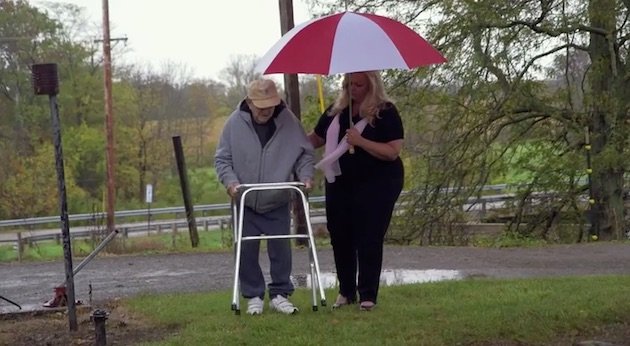What Is Respite Care? Helpful Relief for Caregivers
To continue providing the best care for your loved one, you must also prioritize your health. One of the most effective ways to ensure your mental and physical well-being, despite the difficulties of family caregiving, is to take advantage of respite care.
Respite care provides short-term relief for individuals or families who serve as full-time caregivers for an older adult needing around-the-clock care. Whether you choose in-home care, adult day care, or a residential facility, respite services are known for increasing caregiver resilience and improving your overall quality of life.
In this guide, I will address the importance and benefits of respite care, the types of service available, finding and paying for care, and solutions for common obstacles to care. Read on to learn everything you need about respite care for family caregivers.
Pro Tip:If you’re looking to protect a loved one who lives alone, then a medical alert system can help. To find options from $20 per month, read our guide to this year’s best medical alert systems.

Who Needs Respite Care?
Anyone serving as a primary caregiver can benefit from respite care; however, those who are neglecting their own health issues due to caregiving will benefit most from respite services.
Benefits of Respite Care
Whether leaving a loved one for several hours a week or a month-long stay at a residential facility, caregivers who take respite care are far less likely to experience caregiver burnout. Additionally, caregivers who elect for respite care tend to have more patience and energy and less stress.
Given that 40-70 percent of caregivers show symptoms of depression and half of that population meets the diagnostic criteria for major depression, respite care is an investment worth making. It promotes positive mental health and allows caregivers to rest and recharge. Additionally, respite care provides interested families with a chance to test out residential facilities without any long-term commitments.
Respite Care Services
All respite care services are designed to provide older adults with a safe and comfortable setting that meets their individual needs while they are away from their primary caregiver. While the location and level of carer training will vary based on the type of respite care you choose, most respite care options provide some or all of the following services:
- Companionship
- Activities of daily living (bathing, dressing, etc.)
- Grocery shopping
- Cooking
- Exercise
- Medication management
- Recreational activities (art, music, spending time outdoors)
- Memory care
- Skilled nursing
Pro Tip: Plan your respite time. If you only have a few hours, less is often more. Commit to one activity and really enjoy it. Rushing from one activity to another will leave you feeling stressed and worn out, which is the opposite of the purpose of respite care.
Types of Respite Care
As a primary caregiver, you can select the respite care option that best fits your needs and those of your family. There are two major categories within respite care: in-home care and out-of-home care. The type you choose will depend on where you want your loved one’s care to take place and how much you are willing to pay for it. If you prefer, you can try out different types of care or alternate between them based on your needs.
In-Home Respite Care
If you want your loved one to be able to remain in their home during care, in-home services are the obvious choice. This type of care allows them to remain in their own home and follow their usual daily routine, an arrangement that is especially helpful for those with dementia and related conditions requiring memory care.

A variety of individuals may provide in-home respite services. If your loved one needs help with only a few daily activities, a personal caregiver or home health aide is a wise solution. Should they simply need companionship and someone to deliver groceries and help with meal prep, a local volunteer is a viable option. If, however, their needs are more serious, such as a mid-to-late-stage memory disorder or a disability requiring frequent medical attention, hiring a skilled nurse is more appropriate.
Each of these in-home respite services can last anywhere from a few hours to several days, including overnight. If your loved one needs someone nearby 24/7, you should use an agency. That way, if someone cannot show up, the agency will send another carer in their place so that you won’t have to worry about whether your loved one is being cared for or be burdened with finding a replacement caregiver at the last minute.
Out-of-Home Respite Care
If you need extended respite care or your loved one is a social butterfly and would enjoy the chance to get to know more people, out-of-home respite care is a great choice. Care options under this category include the following:
- Adult day care: Adult day care monitors patients at all times. While day cares do not offer overnight services, they’re the perfect way to get up to a 12-hour breather from your responsibilities as a family caregiver. Seniors who spend time at adult day care centers enjoy various activities such as age-appropriate exercises, art and music classes, and prepared lunches.
- Assisted living or nursing facilities: Equipped with trained staff who are available 24/7, some assisted living and nursing home facilities also offer short-term respite care. Residential respite care is a reasonable option for families who need respite care for a few weeks or even a couple of months. For families considering moving a family member into a care home permanently, short-term respite care provides an opportunity to test out different facilities and assess each one.
FYI: Read my guide, Alternatives to Assisted Living, to learn about different residential care options.
Respite Care Costs
Respite care costs vary based on setting, service length, provider’s qualifications, and the specific aid required. While respite care can potentially be costly, starting at less than $20 per hour, certain insurance policies, government programs, and nonprofits can often help defray your expenses.
In many cases, the most affordable respite care solution is adult day care, which costs an average of $74 per day, according to the U.S. Administration on Aging. Also fairly affordable is in-home respite care provided by home health aides or homemakers, which is about $24 per hour. The price of these services covers everything from helping with activities of daily living to medication management, errands, companionship, and more.

Among the more expensive respite care choices is out-of-home or residential care. The national median cost per day is $147 at an assisted living facility and $290 at a nursing home. However, for short-term respite stays, you’ll likely be charged an extra 10-20 percent per day. Fees for out-of-home services cover room and board, aid with activities of daily living, meals, recreational activities, and more.
Savings tip: You may qualify for free or discounted respite care through the National Association of Area Agencies on Aging or the National Volunteer Caregiver Network. Additionally, read my guide, How to Get Paid to Be a Caregiver, to learn about performing the care yourself.
How to Pay for Respite Care
Although most health insurance plans do not cover respite care in full, there are a few ways to keep your expenses to a minimum.
If your loved one is enrolled in hospice care, Medicare will typically cover up to five consecutive days of in-patient respite care on an occasional basis. Unfortunately, it does not frequently cover respite care for other conditions. However, in many states, if your loved one is on Medicaid, you should be able to limit your out-of-pocket expenses for respite care.
In addition to government-based insurance, long-term care policies and veterans’ programs are also known for subsidizing the high cost of respite care. Nonprofit and private donors are another means of lowering your respite care costs, but they usually provide aid for specific medical issues such as dementia.
Finding Respite Care
Once you decide on the type of respite care, ask around about specific individuals, agencies, or facilities in your local area that may be able to meet your needs. Your loved one’s health care providers may have some insight into this area, and members of nearby caregiver support groups can often provide helpful information based on their firsthand experience. Additionally, you can utilize online resources such as the ARCH National Respite Network’s Respite Care Locator.
Consider asking providers the following questions before signing any care contracts:
- Are you a licensed provider? What is your licensing information?
- What services are included in your quoted price?
- Can you provide references?
- Do you offer transportation?
- What credentials do you or your caregivers carry?
- What makes you or your service unique as a respite care provider?
Respite Care Obstacles
Some caregivers don’t use respite care because of a lack of knowledge regarding its existence and notable benefits. Others hesitate due to fear that others will not be able to manage their loved one’s complex caregiving routines, guilt that they can’t do it all, difficulty finding care, financial hardship, and other reasons.
As for the fear that someone else won’t be able to care for your loved one as well as you can, you may be right. After all, no one knows your loved one or their needs better than you do. However, if you do your research and hire a trained professional to take over your duties, they’ll likely do a good job. It may not be the exact way you do it, but your health and downtime are essential. Without this help, your ability to care for your older family member may suffer.

For caregivers who struggle with their own guilt about taking time off or guilt caused by the individual they’re caring for, you have no reason to feel guilty, no matter what your family member tells you.
Remember that quality is more valuable than quantity in this situation. You must take time for yourself. As a result, you’ll feel re-energized, which will help you to be a better caregiver. If your older parent is guilt-tripping you, remember that this is most likely caused by fear. Consider being present for the first time or two a home health aide is there so that you can ease the transition.
Also, keep in mind that you need to set boundaries with your loved one, much like they probably did with you when you were a child. You should not have to be responsible for all of their care. Besides, with other carers, they may make a new friend or be introduced to a new meal or hobby. Don’t deprive them of that.
You can frequently address issues like financial hardship and difficulty finding care by involving additional family members.
Tip: Don’t wait until you have a breakdown to start taking respite time. By then, it will take you longer to recover. In addition, choosing to involve family can help you address issues like financial hardship and difficulty finding care.
Alternatives to Paid Respite Care
Not all respite care has to be expensive. Sometimes it may even be free:
- Find volunteers: One method of getting free respite care is to apply for volunteer care through nonprofits in your local community. You might start looking at regional organizations that specialize in respite care. For example, CarePartners is a good option in Washington state.
- Make a trade with other caregivers: Speak to another caregiver you trust and propose a trade of caregiving services. For example, you might choose to watch both older adults at once for two afternoons per month so that on two other occasions, that caregiver can do the same for you, thus freeing you up for two afternoons each month.
Incorporating the Family
There are numerous ways you can lighten your burden as a caregiver by allowing your family to take part in your loved one’s care, even those who don’t live nearby. Keep in mind that family members who are not currently involved in the daily care of a parent or other loved one are unlikely to know what you are going through unless you share that with them.

When you make your needs known to your family, ask them if they are able to contribute to respite care and how often. For example, local family members may be able to take over the care of your loved one once a month. For those who live in other areas but can travel, they may be able to come to you and replace you as the primary caregiver for a week or two each year.
For some family members, especially those who live far away, physically helping with caregiving duties may not be possible. However, they may be able to contribute financially toward bringing in a private caregiver or sending your loved one to adult day care.
Getting Started With Respite Care
For the over 35 million U.S. adults who serve in the demanding role of primary caregiver for an older family member, respite care is a vital resource. Those who take advantage of respite services tend to have more energy and perform more effectively as caregivers.
If you’re a family caregiver searching for respite care, identify whether you need in-home or out-of-home care. Then contact the appropriate local service for your loved one, such as respite and home health care agencies, adult care centers, and assisted living facilities.
Ask questions about cost, caregiver credentials, availability, cost, and more. Feel free to ask as many questions as you need until you feel comfortable. After all, this is about both your and your loved one’s well-being. Once you’ve narrowed down your options, ask for references, who can give you details about each provider’s services, dependability, and integrity. If you do your research ahead of time, you’ll be able to enjoy your respite even more, knowing that your loved one is in good hands.
Remember, respite care is key to ensuring that you as a caregiver remain healthy, both physically and mentally, so that you can provide the best care possible for your loved one.
To learn more about everything related to caregiving, read my comprehensive caregiving guide.
